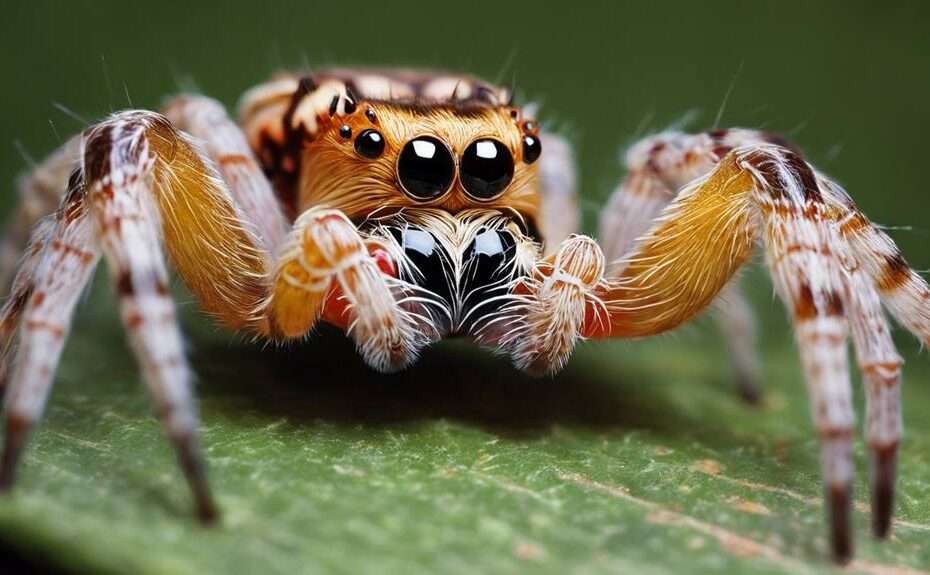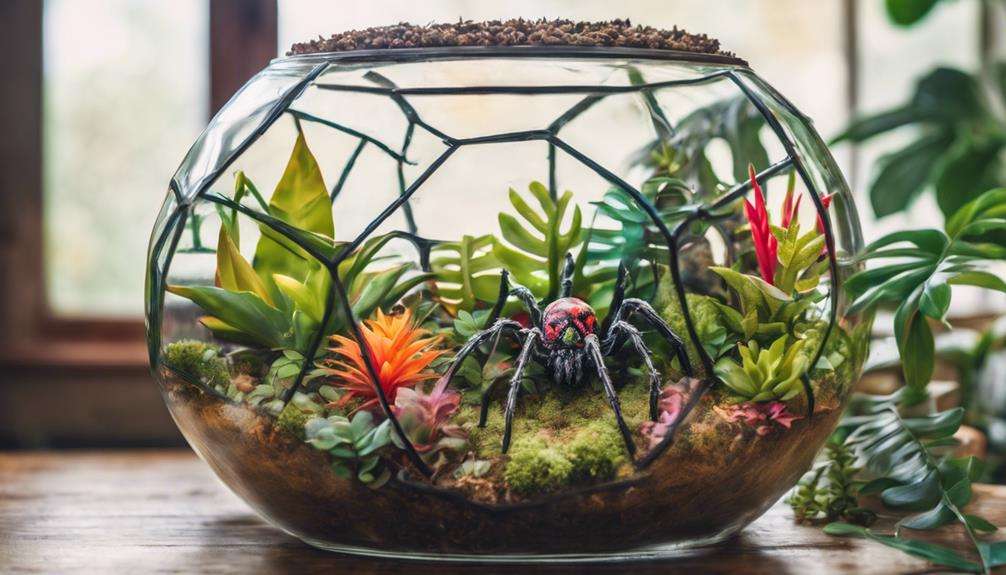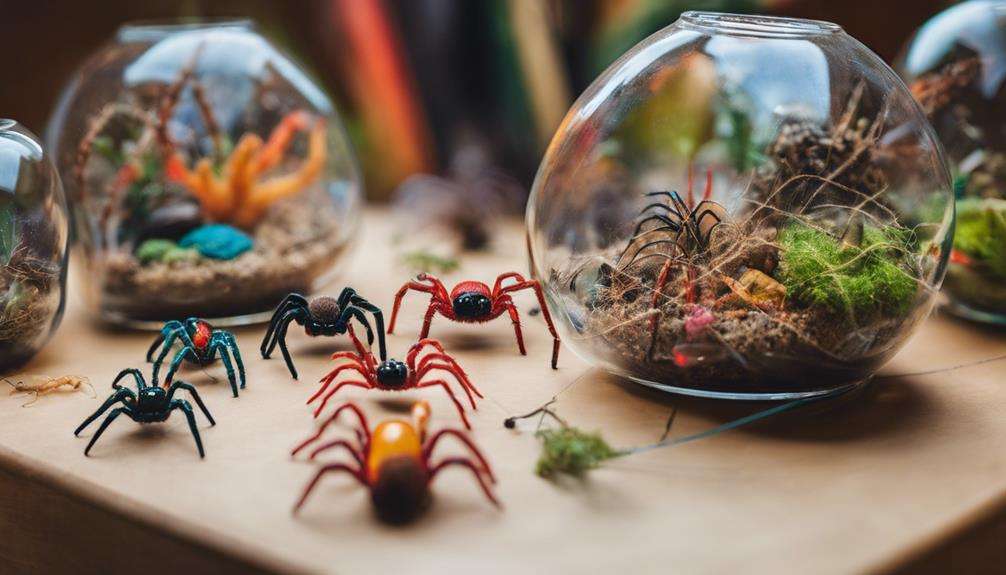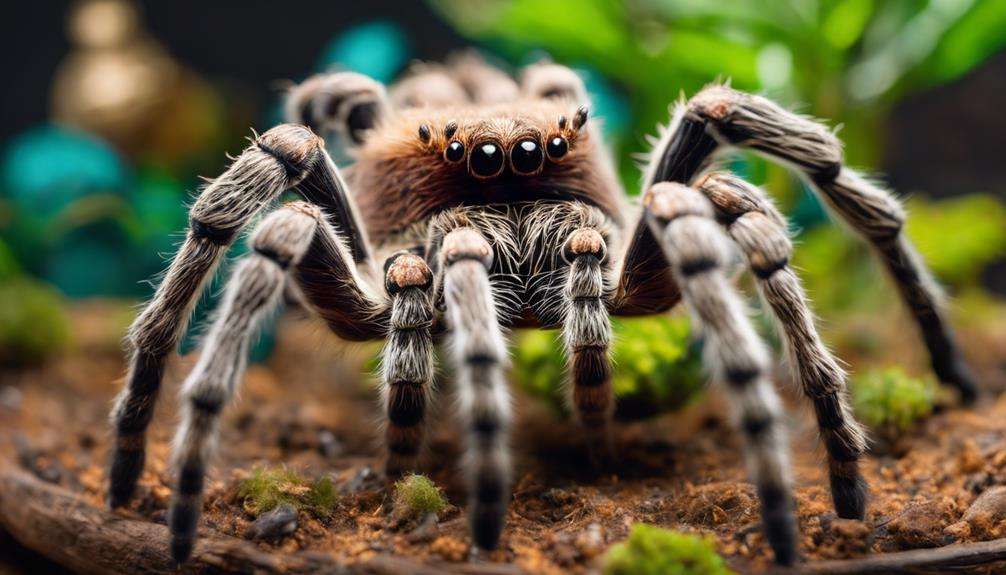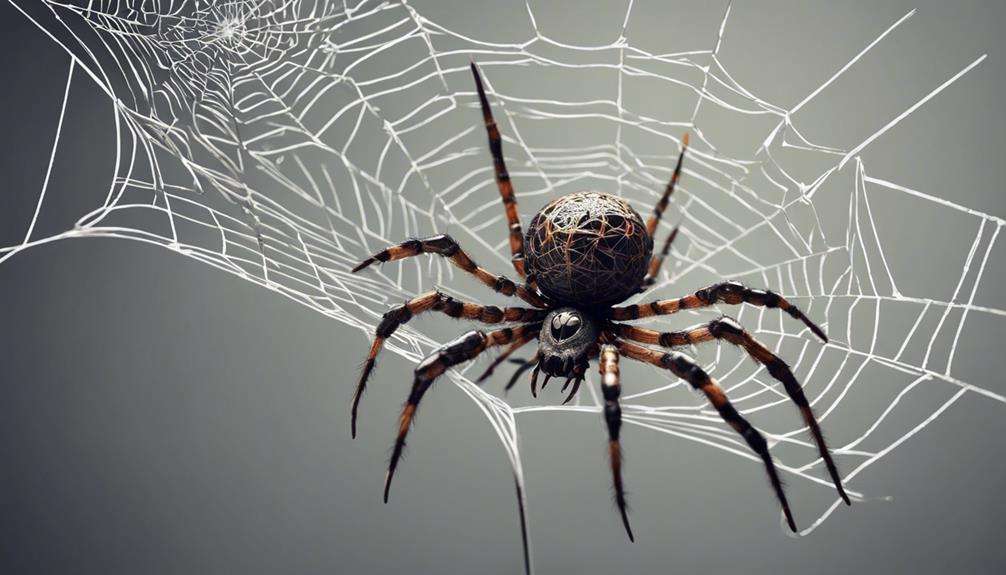If you thought spiders were only meant to be observed from a distance, think again. Among the vast array of pet spider breeds, some stand out for their unique characteristics and exotic allure.
From the Golden Blue Leg Tarantula with its striking metallic blue legs to the Brazilian Salmon Pink Bird-Eater known for its impressive size and vibrant coloration, each breed offers a glimpse into the fascinating world of arachnids.
But what sets these top pet spider breeds apart, and what makes them ideal companions for those seeking a touch of the extraordinary in their homes?
Key Takeaways
- Beginners can start with Golden Blue Leg or Mexican Red-Leg Tarantulas for ease of care.
- Exotic enthusiasts may prefer Brazilian Salmon Pink Bird-Eaters or Peacock Parachute Tarantulas.
- Experienced keepers might enjoy Venezuelan Sun Tiger or Tanzanian Olive Baboon Tarantulas.
- Specific care seekers should consider Malaysian Earth Tiger or Indian Ornamental Tree Spiders.
Golden Blue Leg Tarantula
The Golden Blue Leg Tarantula, also known as Phormingochilus everetti, showcases a stunning blend of golden-blue legs against a dark body, making it a visually enchanting spider breed native to Malaysia.
This exotic pet, favored by many enthusiasts, is particularly appealing due to its essential nature, which makes it a suitable choice for both beginners and seasoned tarantula keepers.
To guarantee the well-being of your Golden Blue Leg Tarantula, it's vital to replicate its natural habitat by providing a warm and humid environment in captivity. This species thrives in temperatures ranging from 75-85°F (24-29°C) with humidity levels of around 70-80%.
Creating a suitable living space for your pet tarantula won't only promote its health but also allow you to observe its fascinating behavior up close. Remember, with proper care and attention, these alluring creatures can live relatively long lives, with females reaching up to 15-20 years and males around 5-7 years.
Brazilian Salmon Pink Bird-Eater
The Brazilian Salmon Pink Bird-Eating Tarantula, scientifically known as Lasiodora parahybana, is a strikingly large species that can reach impressive sizes. This tarantula showcases a vibrant salmon-pink coloration with a dense covering of fine hairs.
When caring for this species, attention to its specific needs and cautious handling are essential due to its potential to release irritating urticating hairs when stressed.
Size and Appearance
One of the largest and most striking tarantula species in the world, the Brazilian Salmon Pink Bird-Eating Tarantula is renowned for its friendly demeanor and unique appearance. This species, also known as Lasiodora parahybana, boasts a considerable size, with leg spans reaching up to 10 inches.
Its body showcases a beautiful salmon-pink hue, enhanced by darker markings on its legs, creating a visually engaging contrast. Despite its intimidating size, this tarantula is often described as friendly and obedient by experienced keepers.
The Brazilian Salmon Pink Bird-Eating Tarantula's impressive size and striking appearance make it a popular choice among arachnid enthusiasts looking for an exotic and visually appealing pet spider to admire from a safe distance.
Care and Temperament
Moving on to the care and temperament of the Brazilian Salmon Pink Bird-Eating Tarantula, understanding its unique needs and behavior is essential for a harmonious pet-owner relationship.
As one of the largest tarantula species, the Brazilian Salmon Pink requires careful handling due to its ability to shoot irritating hairs when threatened. Despite its large size, this tarantula is known for its friendly and obedient temperament, often residing above ground in its habitat.
Discovered in 1917, this species stands out as one of the most attractive and unique among tarantulas, engaging enthusiasts with its stunning appearance and intriguing behaviors. For new owners, it's advisable to exercise caution when handling the Brazilian Salmon Pink Bird-Eating Tarantula to make a positive experience with this fascinating arachnid.
Mexican Red-Leg Tarantula
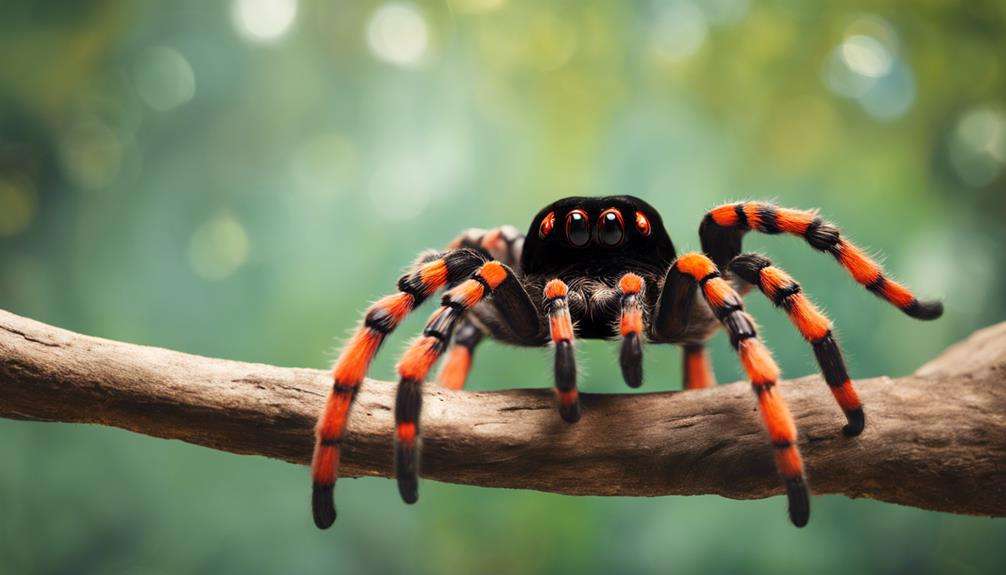
The Mexican Red-Leg Tarantula boasts a striking appearance with vibrant leg colors that make it stand out among other tarantula species.
When caring for this species, it's essential to provide a tank size of 5-10 gallons to guarantee their well-being in captivity.
With regard to temperament, Mexican Red-Leg Tarantulas are known for their docile nature, making them an excellent choice for those new to keeping spiders as pets.
Unique Appearance Features
Featuring vibrant red-orange knees and a dark body, the Mexican Red-Leg Tarantula stands out for its striking and unique appearance. Its colorful legs contrast beautifully with the deep black hue of its body, creating a visually alluring sight.
The docile nature of this species adds to its appeal, especially for beginners looking to start their arachnid collection. The Mexican Red-Leg Tarantula's physical features, including its red-orange knees and dark body, make it a popular choice among spider enthusiasts.
The combination of vibrant colors and calm demeanor make this tarantula a fascinating and low-maintenance pet for those venturing into the world of exotic spiders.
Care and Maintenance Tips
For best care and maintenance of your Mexican Red-Leg Tarantula, make sure the tank size is suitable and the temperature range falls between 75-85°F.
Mexican Red-Leg Tarantulas are docile but easily startled, so handle them with care. A tank size of 5-10 gallons provides ample space for their comfort.
These tarantulas have a physical length of around 5-6 inches and a weight of 0.5-1 ounce, featuring a dark body and colored legs with a distinctive black triangle on their abdomen.
It's important to maintain a temperature range of 75-85°F to guarantee the well-being and comfort of your Mexican Red-Leg Tarantula in captivity.
Temperament and Behavior
With a reputation for docility and longevity, Mexican Red-Leg Tarantulas make an excellent choice for both novice and seasoned arachnid enthusiasts.
These tarantulas can live up to 30 years for females and 5 years for males, offering a long-term pet option. Known for their calm demeanor, they can be easily startled, requiring a temperature range of 75-85°F for best care.
Mexican Red-Leg Tarantulas typically reach sizes of 5-6 inches in length and weigh between 0.5-1 ounce, boasting a distinctive dark body with colored legs and a black triangle pattern.
While generally docile, these tarantulas may bite when stressed, highlighting the importance of gentle handling practices to thus maintain a harmonious relationship with your pet.
Peacock Parachute Tarantula
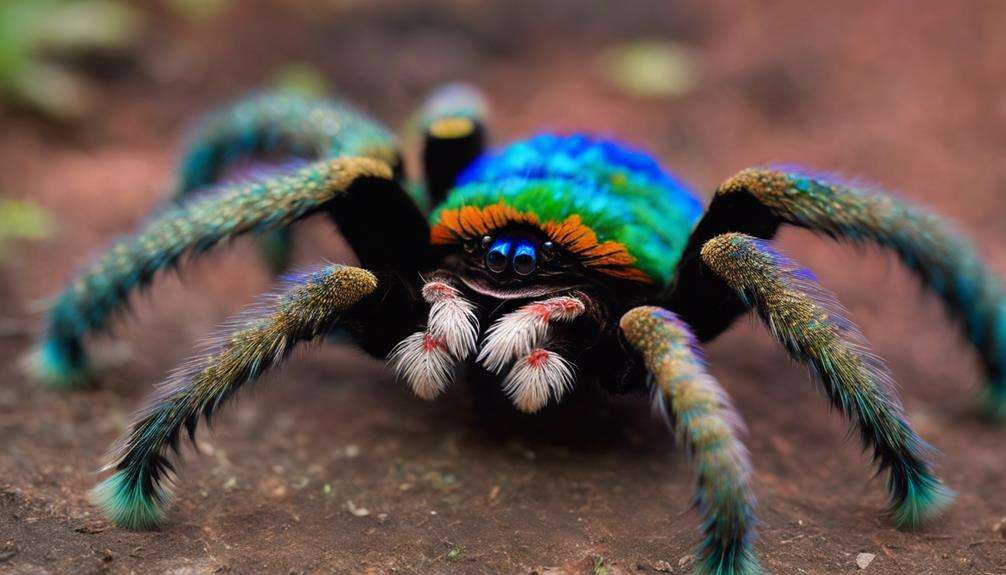
The Peacock Parachute Tarantula, also known as the Gooty Sapphire Ornamental, hails from the dense forests of India and is distinguished by its vibrant metallic blue hue. This critically endangered species is highly coveted by enthusiasts for its stunning appearance. The intricate patterns adorning its body and legs further enhance its allure, making it a prized addition to any collection.
Regarding temperament, the Peacock Parachute Tarantula is known to be fast and agile, necessitating a spacious and well-ventilated habitat to accommodate its active nature. Due to its dwindling population in the wild, conservation efforts and responsible pet ownership are paramount. Supporting initiatives aimed at protecting this species in its natural habitat is essential for ensuring its survival for future generations.
Brazilian Giant White Knee Tarantula
What unique characteristics distinguish the Brazilian Giant White Knee Tarantula, also known as Acanthoscurria geniculata, among tarantula species?
The Brazilian Giant White Knee Tarantula stands out for its striking coloration, boasting a black body adorned with distinct white bands on its legs. Renowned for being docile and easy to care for, this species is a preferred choice among tarantula enthusiasts.
With an impressive leg span that can reach up to 8 inches, these tarantulas require a spacious enclosure equipped with suitable substrate to facilitate their burrowing habits. Ensuring an adequate living environment is essential for their well-being.
In captivity, Brazilian Giant White Knee Tarantulas have a lifespan of approximately 10-15 years, making them a long-term commitment for those looking to keep them as unique and exotic pets. Consider the care requirements and space needed to accommodate these fascinating arachnids before welcoming one into your home.
Venezuelan Sun Tiger Tarantula
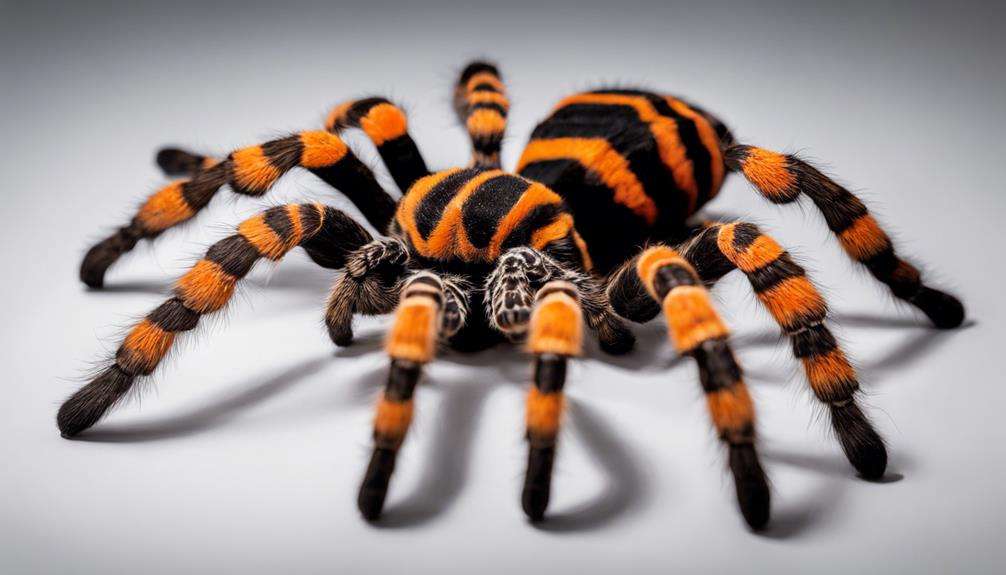
Distinctive for its vibrant colors and agile nature, the Venezuelan Sun Tiger Tarantula, scientifically known as Psalmopoeus irminia, mesmerizes enthusiasts with its stunning orange, black, and white patterns. This species, often referred to as the pink zebra beauty, is among the Best Tarantula Species for those seeking a visually striking and active pet spider. Venezuelan Sun Tigers stand out among the different species due to their beautiful appearance and fast movements, making them a popular choice for experienced spider keepers.
Native to Venezuela, these tarantulas are known for their semi-arboreal nature, displaying behaviors like creating web tunnels or burrows for shelter and hunting. Their curly hair and vibrant coloration set them apart in the world of tarantulas, adding to their appeal as mesmerizing pets. With their active demeanor and eye-catching patterns, Venezuelan Sun Tigers offer enthusiasts a unique and engaging experience in spider keeping.
Malaysian Earth Tiger Tarantula
Originating from Malaysia, the Malaysian Earth Tiger Tarantula, also known as Cyriopagopus thorelli, captivates with its dark coloration and distinctive tiger-like stripes on its legs. This species is renowned for its aggressive behavior, which requires a careful approach, making it more appropriate for experienced spider keepers.
With a leg span reaching up to 6 inches, the Malaysian Earth Tiger Tarantula needs a spacious enclosure furnished with plenty of substrate to facilitate its burrowing habits. These tarantulas are fast growers, with a lifespan of up to 15 years in captivity, showcasing impressive longevity within the tarantula world.
However, due to their defensive nature and potent venom, handling should be done cautiously and with expertise. When considering this striking arachnid as a pet, make sure you have the necessary knowledge and experience to provide a suitable environment and handle them safely.
Tanzanian Olive Baboon Tarantula
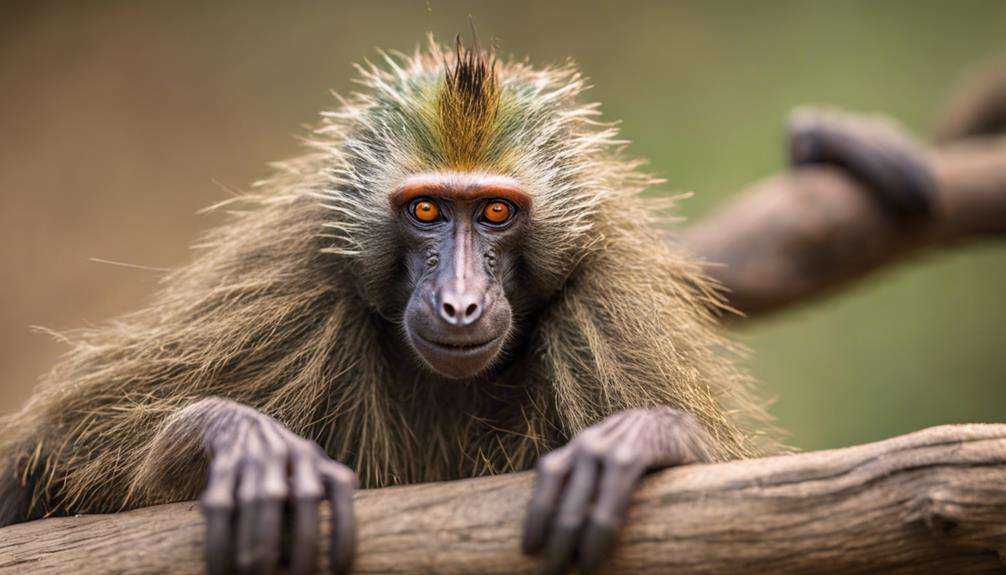
The Tanzanian Olive Baboon Tarantula, a formidable arachnid species renowned for its impressive size and striking appearance, requires specialized care to thrive in captivity. Scientifically known as Hysterocrates gigas, this tarantula originating from Tanzania stands out for its olive-green coloration, adding a unique touch to any collection with its leg span reaching up to 7 inches.
To ensure the well-being of the Tanzanian Olive Baboon Tarantula, it's important to recreate its natural habitat by providing a warm and humid environment within its enclosure. As an advanced pet option, this species demands specific care needs, making it a challenging yet rewarding choice for experienced keepers.
Indian Ornamental Tree Spider
Indian Decorative Tree Spiders are mesmerizing creatures due to their vibrant colors and intricate patterns, making them a visually stunning choice for pet owners. These spiders have an arboreal nature, preferring to dwell in trees or elevated spaces, necessitating a vertically oriented enclosure for their well-being.
It's essential to handle them with care as they possess venomous potential and may bite if provoked, highlighting the importance of cautious interaction with these agile and colorful arachnids.
Colorful and Agile
With vibrant colors and remarkable agility, the Ornamental Tree Spider stands out as a fascinating species among arachnid enthusiasts. The Indian Ornamental Tree Spider displays intricate patterns of black, white, and orange on its body, making it visually striking.
This species is known for its agile and fast-moving nature, adding to its allure as an exotic pet. Tree-dwelling by nature, these spiders construct elaborate webs high above the ground to capture prey efficiently.
To accommodate their active behavior, they require tall tanks with ample climbing space resembling their natural habitat. Despite their beauty, approaching them cautiously is crucial as they can be defensive and may bite if threatened.
Arboreal Habitat Preference
Displaying vibrant colors and intricate patterns, the arboreal habitat preference of the Indian Ornamental Tree Spider, also known as Poecilotheria regalis, is essential for its well-being in captivity.
As a tree-dwelling species native to India and Sri Lanka, this spider thrives in high places, requiring ample vertical space and climbing structures to mimic its natural environment. With a leg span reaching up to 6 inches, the Indian Ornamental Tree Spider showcases agility and speed in moving through its arboreal surroundings.
To meet its dietary needs, these spiders primarily feed on various insects, demonstrating their role as insectivores. Providing a habitat that caters to the arboreal nature of the Indian Ornamental Tree Spider is vital for ensuring its health and happiness in captivity.
Venomous Bite Potential
Known for its potent venomous bite potential, the Indian Ornamental Tree Spider belongs to the Poecilotheria genus, which comprises some of the most venomous tarantula species. Their venom, while not deadly to humans, can cause pain, swelling, and symptoms akin to a bee sting. Due to their potent venom, handling should be avoided to prevent any potential bites.
It's vital to note that the Indian Ornamental Tree Spider isn't recommended for beginners or inexperienced spider keepers due to the risks associated with their venomous bite. Proper caution and respect for these spiders are paramount when considering them as pets, as their venomous nature requires a higher level of expertise in handling and care.
Australian Tarantula
The Australian Tarantula, also known as the Australian bird-eating spider, captivates with its remarkable size and native habitat in Australia. These arachnids boast an impressive size, with some specimens showcasing leg spans of up to 10 inches. Known for being skilled hunters, Australian Tarantulas primarily prey on insects, small reptiles, and even other spiders in their natural environment. While not inherently aggressive towards humans, these tarantulas can deliver a painful bite if provoked.
In captivity, Australian Tarantulas require a warm and dry environment to thrive. To accommodate their needs, a spacious tank with proper ventilation and a substrate that allows for burrowing is essential. Ensuring a suitable temperature and humidity level within the enclosure is vital for the well-being of these creatures. While their venom can be potent, Australian Tarantulas can make fascinating and low-maintenance exotic pets for enthusiasts willing to meet their captivity requirements.
Frequently Asked Questions
What Is the Best Spider to Have as a Pet?
When choosing a pet spider, consider your experience level and preferences. Beginners often opt for species like the Mexican Red Knee Tarantula for ease of care. Advanced keepers may prefer unique species like the Brazilian Salmon Pink Bird-Eating Tarantula.
What Is the Most Friendliest Spider?
Looking to welcome a new arachnid friend into your life? Wondering about the most friendly spider species out there? Consider the Honduran Curly Hair Tarantula for its docile nature and easy care requirements.
Are Spiders Exotic Pets?
Yes, spiders are exotic pets. Spider care requires attention to their behavior, diet, habitats, handling, and personalities. Understanding these aspects is essential for providing proper care to these fascinating creatures and ensuring their well-being in captivity.
What Is the Cute Spider for a Pet?
When it comes to selecting the perfect pet spider, search no more than the Jumping Spider. With its adorable appearance, large expressive eyes, and playful demeanor, these tiny tarantulas make for cuddly crawlers that are bound to steal your heart.
Conclusion
You have explored some of the top pet spider breeds, each with its own unique characteristics and care requirements.
Did you know that the Brazilian Giant White Knee Tarantula can have a leg span of up to 10 inches, making it an impressive sight in any spider enthusiast's collection?
Imagine the striking appearance of this large and vibrant arachnid as it crawls across its enclosure, showcasing its beauty and intriguing behavior.
Consider adding one to your exotic pet collection today!
